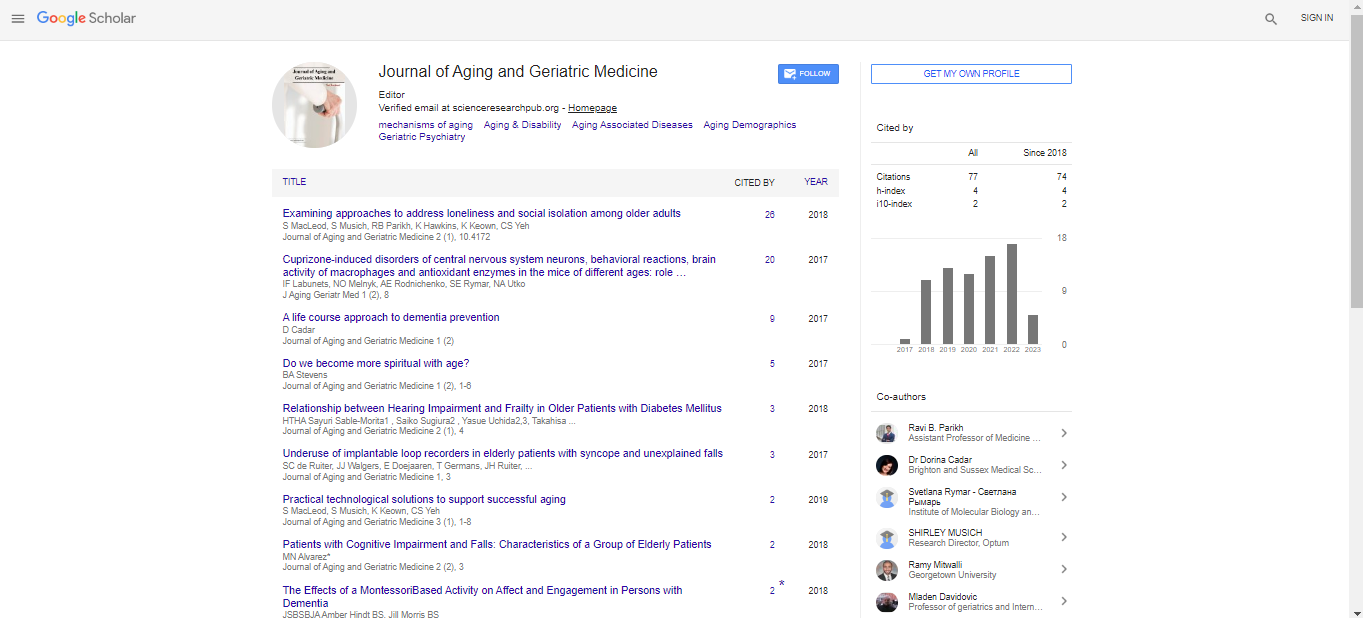Commentary, J Aging Geriatr Med Vol: 8 Issue: 1
Biological Aging is the Slow and Progressive Alterations in Physical Function
Venjqing Zang*
Department of Psychological and Brain Sciences, Drexel University, Philadelphia, USA
- *Corresponding Author:
- Venjqing Zang
Department of Psychological and Brain Sciences,
Drexel University,
Philadelphia,
USA
E-mail: venjqing_zang@gmail.com
Received date: 04 November, 2023, Manuscript No. AGM-23-119218;
Editor assigned date: 07 November, 2023, PreQC No. AGM-23-119218 (PQ);
Reviewed date: 21 November, 2023, QC No. AGM-23-119218;
Revised date: 15 August, 2024, Manuscript No. AGM-23-119218 (R);
Published date: 22 August, 2024, DOI: 10.4172/2576-3946.1000184
Citation: Zang V (2024) Biological Aging is the Slow and Progressive Alterations in Physical Function. J Aging Geriatr Med 8:1.
Description
Both a stochastic and a no stochastic, or planned, senescence process are among the biological processes underlying the aging process. While the theories of programmed senescence maintain that aging is predetermined and results from organized genetic expression, the stochastic theories suggest that aging events occur randomly as genetic mutations and accumulate over time. The theories that have accumulated the greatest throughout time include the immunological theory, the planned longevity hypothesis, the free radical theory, and the evolutionary senescence theory. The simplest definition of biological aging is the slow and progressive alterations in physical function that start in maturity and conclude with death, and they affect all species. According to evolutionary theory, aging is caused by a decrease in the power of natural selection, and longevity will be chosen if it increases an individual's likelihood of surviving. The aging rate patterns and exceptions to these patterns vary throughout species, and the evolutionary senescence theory seems to explain why animals of different species age at all. According to the idea, antagonistic pleiotropy-a type of gene action whereby genes expressed early in life may have beneficial benefits but may have detrimental consequences later in life determines the rate at which species mature. Furthermore, if late-acting harmful genes have any positive effects early in life, natural selection may favour them and they may actively increase in populations, according to the antagonistic pleiotropic theory. This theory's intriguing premise is that aging can only evolve in species with an age structure that is, in species whose somatic and reproductive cells are distinct and in species that have evolved in environments with minimal environmental risk. It is important to remember that different forms of gene action such as inherited germline mutations mediate the evolutionary biology theory.
Most bodily systems undergo modest alterations as we age. Understanding the cellular and molecular mechanisms behind these alterations as well as those concomitant with the beginning of age-related illnesses is the main goal of research on the biology of aging. Experiments may be designed to better understand the onset and progression of pathogenic alterations as scientists gain greater insight into these processes. These insights can be used to develop treatments aimed at preventing or treating illness. The understanding of structural and functional alterations that take place in many bodily systems has advanced significantly, and research continues. Additionally, research has increased our understanding of the physiological elements linked to longer lifespans in human explains some recent developments in the biology of aging, transplantation and cloning, and longevity itself. A few potential avenues for future research are also outlined, such as the on-going pursuit of biologic interventions to support healthy aging, the investigation of the genetic underpinnings of aging, and the potential utility of adult stem cells and cell replacement in the prevention of disease and enhancement of function.
An essential component of aging is the control of the cell cycle. Only when necessary for growth and development (in embryos and the young) or when replacing lost or damaged cells is required should replication take place. Growth factors, proto-oncogenes that promote replication and anti-oncogenes that generate proteins that prevent replication all have an impact on the cycle. In cells that still have the ability to divide, these different elements work together to control how the cell cycle proceeds. Furthermore, if mistakes have occurred, cellular processes serve as checkpoints that stop the cell cycle from continuing. Before the cell enters the S phase, when replication takes place, the first checkpoint, which happens during the G1 phase, gives cellular processes a chance to repair damaged DNA. This stops damaged DNA from being inherited by the daughter cells, which might lead to mutations. In the S and G2 stages, there are additional checkpoints that look for broken DNA and failed DNA replication. At the conclusion of mitosis, there is a final cell cycle checkpoint that looks for mismatched chromosomes. Because cells lose their ability to reproduce until they can no longer divide, the various elements that control the cell cycle have a significant impact on the aging process.
Conclusion
As this happens, the body's capacity to regenerate injured or destroyed cells diminishes, which eventually leads to aging-related decreases in tissue strength and cellular and organ function. Think of natural aging as the result of a certain type of accumulated damage that interferes with a vital cellular function and reduces its efficiency. Gene 1 activity promotes normal lifespan by reducing the rate at which this damage accumulates. Therefore, progeria caused by a mutation in gene 1 will immediately shed light on a process that is the weak point of typical aging.
 Spanish
Spanish  Chinese
Chinese  Russian
Russian  German
German  French
French  Japanese
Japanese  Portuguese
Portuguese  Hindi
Hindi 